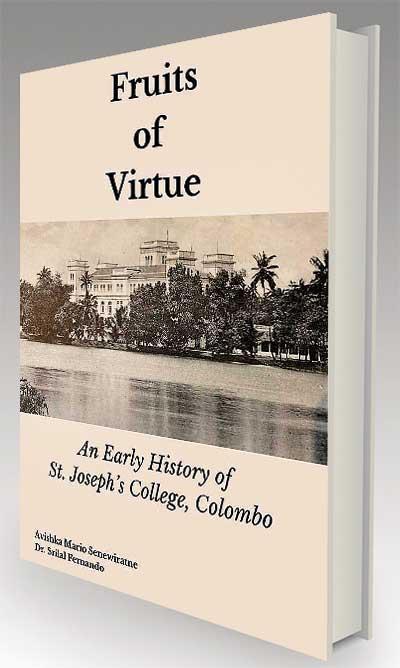31 Jul 2023 - {{hitsCtrl.values.hits}}
When we turned into the College Drive, I was of course, most anxious to get a view of the building, but in those days the present great stretch of playground was covered with fine spreading trees which hid the structure, and it was not until we arrived at the lawn in front of the Lake House that St. Joseph’s College came into view.
days the present great stretch of playground was covered with fine spreading trees which hid the structure, and it was not until we arrived at the lawn in front of the Lake House that St. Joseph’s College came into view.
Description of St. Joseph’s College by a teacher who accompanied Fr. Lytton to the school at the turn of the 20th Century.
The above description by an unnamed teacher quoted in Senewiratne’s textual labour of love, Fruits of Virtue, is perhaps too close to the authors’ own efforts to reign in a historical narrative of one of Sri Lanka’s pioneering Catholic schools, St. Joseph’s College. Senewiratne’s and Fernando’s book is also ‘covered with spreading trees’ as the reader forays into its pages…and absorbs time and space before one gets a broad glimpse of the school: SJC in Senewiratne’s text takes time to reveal itself; it defines attempt to capture it in one measurement —perhaps like any educational space with an extensive history, the school presents itself to the reader in many facets.
Historical narratives about academic spaces are not the easiest texts to write or read owing to administrative and decision-making complexities involved in initiating such projects with far-reaching effects upon people and the nation. Yet, this account of SJC, its conception and its development, somehow manages to overcome such tendencies through a text whose narratives build perspectives and offer vistas of visually-charged chronicles that never allows a reader to settle down to his couch.
 Senewiratne’s SJC narrative is told via an innovative structural mode created by him. It begins with brief biographies of benefactors who dreamed and nurtured an idea for a school that would “bring up men who will be able to occupy responsible posts and to represent worthily the Catholic body.” These biographical sketches of benefactors while offering glimpses into the personal histories of people who lived in a specific time-space continuum also bring out the complexities and challenges involved in initiating an educational institute. A close reading of the narratives of the benefactors could yield polished gems, in terms of their presence felt in the present time. For instance, one of Sri Lanka’s iconic literary figures, ShyamSelvadurai, is a descendant of David de Silva, one of the prominent benefactors of SJC. There are many such gems…awaiting the reader.
Senewiratne’s SJC narrative is told via an innovative structural mode created by him. It begins with brief biographies of benefactors who dreamed and nurtured an idea for a school that would “bring up men who will be able to occupy responsible posts and to represent worthily the Catholic body.” These biographical sketches of benefactors while offering glimpses into the personal histories of people who lived in a specific time-space continuum also bring out the complexities and challenges involved in initiating an educational institute. A close reading of the narratives of the benefactors could yield polished gems, in terms of their presence felt in the present time. For instance, one of Sri Lanka’s iconic literary figures, ShyamSelvadurai, is a descendant of David de Silva, one of the prominent benefactors of SJC. There are many such gems…awaiting the reader.
The struggle for a land to build the school takes the narrative from biographies to more practical realities as the authors attempt to trace the events that led to the location of the present school: from the initial idea of a site at ‘uplands’ in Mutuwal to the Darley Road in Colombo. These narratives are not by all means stagnant texts with inevitable knots created by land ownership, purchase and transfer. Rather, they combine awe-inspiring challenges, timely exertions and even a little bit of folklore carried by the apparent haunting of the site by the devoted chef of the Egyptian revolutionary Orabi Pasha. The other interesting feature was the presence of reptiles and other unwelcome insects. As the Bursar Father Henry Boyer recalls: “.while having refreshments in the coffee room in the bungalow he had dropped his handkerchief and in the attempt at stooping to recover the dropped handkerchief, he put his hands on a wriggling young snake.” The narrative about acquiring the land and settling down is also a narrative of human pioneering spirit and perseverance—a rare initiative whose vitality and enterprise drove it into a space of success.
“It is a mistake to consider the school as an office or workshop. It is no part of a school master’s duty to give his boys technical teaching. His task is to develop the mind and enlighten conscience of his pupils…” thus goes a prize giving speech from Rev. Fr. Lytton who occupies a special chapter in the book. This gritty personality, with an intense love of education and whose pioneering vision made SJC much more than a reality, has been rightfully given a special space in the book. A close reading of this chapter offers the worldview of educationists of the period, who were more interested in cultivating deep inner resources of students than mere passing of examinations: food for thought for present day educators.
The building of the Chapel in the middle of the school is the other chapter whose narrative contains all the elements of an initiative driven beyond its boundaries of possibility. Despite the Great War and the depressing economic circumstances, the pioneers of SJC worked tirelessly to build a chapel which is the center of attraction of the school, and with a vision not only to serve the spiritual needs of the school but the general public as well. The extraordinary efforts of the pioneers gave rise to a creation whose grandeur is aptly captured in the description: “…the new Chapel of St. Joseph’s College stood there glistening white and glinting in the evening sun, a monument perfect in every part, fresh from the hand of the master artists and planted in its own milieu.”
In terms of enhancement, Senewiratne’s book could do with enhanced narratives. The author disrupts a well-formed narrative at some points to bring in a speech or a statement—which could very well go to an Appendix: well-constructed narratives always insert a certain hypnotic power on sustained readership as well as memory. At the same time, his biographical sketches of pioneers of the school could expand so a reader could glimpse the whole personality of the person under focus: when people enter historical narratives with their full personalities, the events gather a rare impetus. His title of the book need not capture the effects of the pioneers, it could have captured their cause—vision, momentum, energy and perseverance—so that the title could have featured vitality and vigour.
Yet, all in all, Fruits of Virtue is an apt reflection and exposition of an event in Sri Lankan history when a school with an impressive vision came into existence amidst the complexities and confusions of the socio-economic and political conditions of the times. Senewiratne’s text acknowledges and celebrates the vision, initiative and practical sensibilities of a group of special individuals whose efforts continue to illuminate the lives of many of the pupils who enter, wish to enter and who graduate and graduated from SJC.
an impressive vision came into existence amidst the complexities and confusions of the socio-economic and political conditions of the times. Senewiratne’s text acknowledges and celebrates the vision, initiative and practical sensibilities of a group of special individuals whose efforts continue to illuminate the lives of many of the pupils who enter, wish to enter and who graduate and graduated from SJC.
10 Jan 2025 9 minute ago
10 Jan 2025 29 minute ago
10 Jan 2025 2 hours ago
10 Jan 2025 2 hours ago
10 Jan 2025 2 hours ago